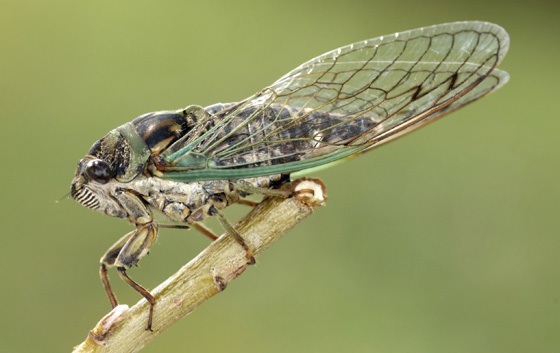
The
Staten Island Museum may be billed as a “general interest” museum, but its exhibitions tend to hone in on specific, eclectic subject matter. Take, for instance, its current exhibit on cicadas,
They’re Baaack! Return of the 17-Year Cicadas. The exhibit is an homage to one of the museum’s founders, William T. Davis—otherwise known as “the Cicada Man of Staten Island”—and boasts the largest collection of cicadas in the Americas. In the late 19th century, Davis fell in love with the insect and turned an amateur interest into a career. He became one of the world’s leading expert on cicadas, dubbing New York state’s most prevalent species
Magicicada and receiving specimens from entomologists all over the world.
The Staten Island Museum’s current director of exhibits, Diana Matys, shares Davis’s enthusiasm for the insect. Though she is responsible for exhibits about the Staten Island Ferry and the museum’s venerable collection of art, she maintains that the cicada exhibit is the biggest attraction. Below, Diana dispels some myths about the creature and shares some interesting facts.
GROUPON: Let’s say I have a child who is afraid of insects. Let me be clear that I am in no way referring to myself, here…What activities would you recommend to get myself—I mean, my child—comfortable and even excited about cicadas?
DIANA MATYS: Go outside on a regular basis and look at insects up close to see that they are really interesting creatures that
usually mean us no harm.
G: How should you greet a cicada should you see one in the wild?
DM: Hold your hands over your ears and bow at the waist.
G: Who are the cicadas’ natural allies? Who are their arch-nemeses?
DM: They are their own best friends, and their ally is any tree! Everything eats the periodical [cicadas], but the cicada killer wasps are [their] most dramatic enemy. These giant wasps sting and immobilize a cicada, drag it underground, lay a single wasp egg in its body [...] then the baby wasp eats [its] LIVING host as it develops.
G: Do cicadas feel fear? How do they show it?
DM: Cicadas fear nothing, which is probably why
everything eats them.
G: Who would win—a cicada or a black widow?
DM: Cicadas are looking for love, not itching for a fight.
G: What might I be surprised to discover about cicadas?
DM: The periodical cicada is found only in North America. [These] periodical cicadas are
not locusts (this is a different species known to destroy crops), but early Puritan colonists probably saw an emergence, connected them [to] the Biblical plagues, and called them “locusts”…people still use that moniker!
G: Are cicadas significant to any other cultures around the world?
DM:
South of France: Good-luck symbol
Mexico: A great mariachi song! See Linda Ronstadt’s [
"The Cicada/La Cigarra," from her album]
Canciones de Mi Padre
China: In Chinese lore, the cicada was also associated with integrity, as the adult lives on the highest branches and was believed to subsist only on pure dew.
G: Does the cicada make an appearance in any other pieces of folklore?
DM: Aesop told a moralistic fable about preparing for the future called
The Cicada and the Ant. Much later, French poet and fabulist Jean de La Fontaine (1621–1695) wrote a popular adaptation of this fable called
La Cigale et La Fourmi. However,
la cigale (the cicada) was often misinterpreted as a cricket or a grasshopper. The French composer Jules Massenet wrote a tragic ballet score based on this version, and many other composers have musically adapted this fable.
G: Let’s flash-forward to present day. Any other unexpected cicada stories to share?
DM: On June 1, 2011, Sparky’s Homemade Ice Cream in Columbia, Missouri, debut its first and only batch of cicada ice cream. The dead bugs were collected by employees in their backyards, de-winged, boiled, and then covered with brown sugar and milk chocolate. They were mixed into an ice-cream base of brown sugar and butter flavor. Almost as soon as the ice cream was offered to an eager public, it sold out!
G: Which goes better with cicada—red or white wine?
DM: I prefer a nice sauvignon blanc or chardonnay.
G: Are cicadas “gateway insects” into a fascination with weirder and larger bugs?
DM: Yes. An apparently normal person, once hooked on cicadas, could go onto more extreme activities, such as breeding giant silk moths in their spare time, going on insect-themed vacations, or even making a career out of working in [a] museum attic, surrounded by hundreds of thousands of preserved insects. There is no limit to the mania.
Outside of the exhibit, the Staten Island Museum will host a series of cicada hikes every Sunday in June, an outdoor NatureFest on Saturday, June 8, in Willowbrook Park, and an Earth Camp in July for kids interested in learning more. Through the museum’s citizen science project, civilians can learn how to recognize cicada songs and learn about the cicada population of Staten Island. See the exhibit’s official site and blog for more information.


 The
The 